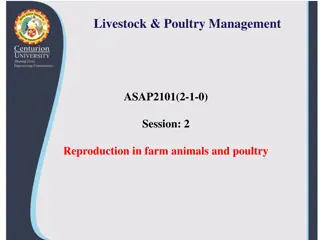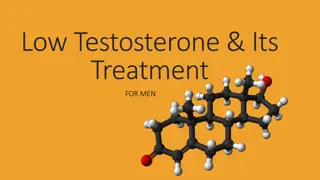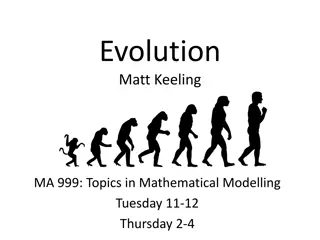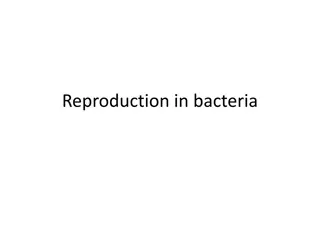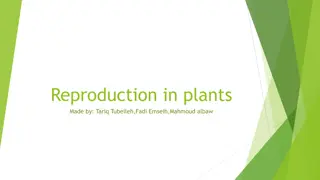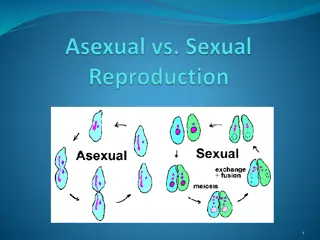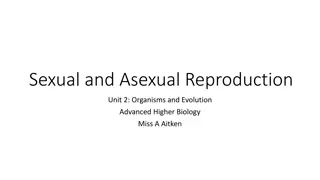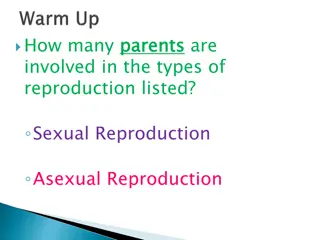Understanding Testosterone and Sexual Reproduction in Human Males
Testosterone is secreted in the human male body by the testes and plays a crucial role in the development of secondary sexual characteristics, sperm production, and libido. This hormone is essential for male reproductive functions and overall health. The iQuiz content provides detailed information on the structures involved in sexual reproduction and the role of testosterone in male physiology.
Download Presentation

Please find below an Image/Link to download the presentation.
The content on the website is provided AS IS for your information and personal use only. It may not be sold, licensed, or shared on other websites without obtaining consent from the author. Download presentation by click this link. If you encounter any issues during the download, it is possible that the publisher has removed the file from their server.
E N D
Presentation Transcript
3.6.2 Sexual Reproduction in the Human Structures and Hormones Follow-Me iQuiz
Q. Where is testosterone secreted in the body of the human male? Loss of blood; Loss of endometrium Allows sperm to swim; Provides nutrients; Lubricant; Protects sperm Seminal fluid production; Nutrition of sperm Loss of blood; Loss of endometrium Seminal fluid production; Nutrition of sperm Allows sperm to swim; Provides nutrients; Lubricant; Protects sperm Size; Shape; Motile; Chromosomal difference Monthly cycle in female; Lining of uterus (endometrium) shed; Blood discharged Size; Shape; Motile; Chromosomal difference Monthly cycle in female; Lining of uterus (endometrium) shed; Blood discharged Broken voice; Body hair; More muscle; Enlargement of testes; Enlargement of penis Broken voice; Body hair; More muscle; Enlargement of testes; Enlargement of penis Sperm cells and seminal fluid Sperm cells and seminal fluid Ovary Testis Cowper s gland; Seminal vesicles; Prostate gland Cowper s gland; Seminal Ovary Testis Development of secondary sexual characteristics; Development of sex organs; Sperm production vesicles; Prostate gland Oviducts Testosterone Development of secondary sexual characteristics; Development of sex organs; Sperm production Oviducts Testosterone Puberty Time when fertilisation is possible; Egg is in oviduct Time when fertilisation is possible; Egg is in oviduct Puberty Release of egg from ovary To carry sperm Epididymis Release of egg from ovary To carry sperm Epididymis Respiration; Produce energy Uterus Fallopian tube Respiration; Produce energy Uterus Fallopian tube
CONGRATULATIONS Please CLICK on THIS BOX for the Next Question Please CLICK on THIS BOX for the Next Question
Q. Give a brief account of the role of testosterone. Loss of blood; Loss of endometrium Allows sperm to swim; Provides nutrients; Lubricant; Protects sperm Seminal fluid production; Nutrition of sperm Loss of blood; Loss of endometrium Seminal fluid production; Nutrition of sperm Allows sperm to swim; Provides nutrients; Lubricant; Protects sperm Size; Shape; Motile; Chromosomal difference Monthly cycle in female; Lining of uterus (endometrium) shed; Blood discharged Size; Shape; Motile; Chromosomal difference Monthly cycle in female; Lining of uterus (endometrium) shed; Blood discharged Broken voice; Body hair; More muscle; Enlargement of testes; Enlargement of penis Broken voice; Body hair; More muscle; Enlargement of testes; Enlargement of penis Sperm cells and seminal fluid Sperm cells and seminal fluid Ovary Testis Cowper s gland; Seminal vesicles; Prostate gland Cowper s gland; Seminal Ovary Testis Development of secondary sexual characteristics; Development of sex organs; Sperm production vesicles; Prostate gland Oviducts Testosterone Development of secondary sexual characteristics; Development of sex organs; Sperm production Oviducts Testosterone Puberty Time when fertilisation is possible; Egg is in oviduct Time when fertilisation is possible; Egg is in oviduct Puberty Release of egg from ovary To carry sperm Epididymis Release of egg from ovary To carry sperm Epididymis Respiration; Produce energy Uterus Fallopian tube Respiration; Produce energy Uterus Fallopian tube
CONGRATULATIONS Please CLICK on THIS BOX for the Next Question Please CLICK on THIS BOX for the Next Question
Q. Name a gland that secretes seminal fluid. Loss of blood; Loss of endometrium Allows sperm to swim; Provides nutrients; Lubricant; Protects sperm Seminal fluid production; Nutrition of sperm Loss of blood; Loss of endometrium Seminal fluid production; Nutrition of sperm Allows sperm to swim; Provides nutrients; Lubricant; Protects sperm Size; Shape; Motile; Chromosomal difference Monthly cycle in female; Lining of uterus (endometrium) shed; Blood discharged Size; Shape; Motile; Chromosomal difference Monthly cycle in female; Lining of uterus (endometrium) shed; Blood discharged Broken voice; Body hair; More muscle; Enlargement of testes; Enlargement of penis Broken voice; Body hair; More muscle; Enlargement of testes; Enlargement of penis Sperm cells and seminal fluid Sperm cells and seminal fluid Ovary Testis Cowper s gland; Seminal vesicles; Prostate gland Cowper s gland; Seminal Ovary Testis Development of secondary sexual characteristics; Development of sex organs; Sperm production vesicles; Prostate gland Oviducts Testosterone Development of secondary sexual characteristics; Development of sex organs; Sperm production Oviducts Testosterone Puberty Time when fertilisation is possible; Egg is in oviduct Time when fertilisation is possible; Egg is in oviduct Puberty Release of egg from ovary To carry sperm Epididymis Release of egg from ovary To carry sperm Epididymis Respiration; Produce energy Uterus Fallopian tube Respiration; Produce energy Uterus Fallopian tube
CONGRATULATIONS Please CLICK on THIS BOX for the Next Question Please CLICK on THIS BOX for the Next Question
Q. Where does meiosis occur in the human male reproductive system? Loss of blood; Loss of endometrium Allows sperm to swim; Provides nutrients; Lubricant; Protects sperm Seminal fluid production; Nutrition of sperm Loss of blood; Loss of endometrium Seminal fluid production; Nutrition of sperm Allows sperm to swim; Provides nutrients; Lubricant; Protects sperm Size; Shape; Motile; Chromosomal difference Monthly cycle in female; Lining of uterus (endometrium) shed; Blood discharged Size; Shape; Motile; Chromosomal difference Monthly cycle in female; Lining of uterus (endometrium) shed; Blood discharged Broken voice; Body hair; More muscle; Enlargement of testes; Enlargement of penis Broken voice; Body hair; More muscle; Enlargement of testes; Enlargement of penis Sperm cells and seminal fluid Sperm cells and seminal fluid Ovary Testis Cowper s gland; Seminal vesicles; Prostate gland Cowper s gland; Seminal Ovary Testis Development of secondary sexual characteristics; Development of sex organs; Sperm production vesicles; Prostate gland Oviducts Testosterone Development of secondary sexual characteristics; Development of sex organs; Sperm production Oviducts Testosterone Puberty Time when fertilisation is possible; Egg is in oviduct Time when fertilisation is possible; Egg is in oviduct Puberty Release of egg from ovary To carry sperm Epididymis Release of egg from ovary To carry sperm Epididymis Respiration; Produce energy Uterus Fallopian tube Respiration; Produce energy Uterus Fallopian tube
CONGRATULATIONS Please CLICK on THIS BOX for the Next Question Please CLICK on THIS BOX for the Next Question
Q. Where are sperm stored in the human male reproductive system? Loss of blood; Loss of endometrium Allows sperm to swim; Provides nutrients; Lubricant; Protects sperm Seminal fluid production; Nutrition of sperm Loss of blood; Loss of endometrium Seminal fluid production; Nutrition of sperm Allows sperm to swim; Provides nutrients; Lubricant; Protects sperm Size; Shape; Motile; Chromosomal difference Monthly cycle in female; Lining of uterus (endometrium) shed; Blood discharged Size; Shape; Motile; Chromosomal difference Monthly cycle in female; Lining of uterus (endometrium) shed; Blood discharged Broken voice; Body hair; More muscle; Enlargement of testes; Enlargement of penis Broken voice; Body hair; More muscle; Enlargement of testes; Enlargement of penis Sperm cells and seminal fluid Sperm cells and seminal fluid Ovary Testis Cowper s gland; Seminal vesicles; Prostate gland Cowper s gland; Seminal Ovary Testis Development of secondary sexual characteristics; Development of sex organs; Sperm production vesicles; Prostate gland Oviducts Testosterone Development of secondary sexual characteristics; Development of sex organs; Sperm production Oviducts Testosterone Puberty Time when fertilisation is possible; Egg is in oviduct Time when fertilisation is possible; Egg is in oviduct Puberty Release of egg from ovary To carry sperm Epididymis Release of egg from ovary To carry sperm Epididymis Respiration; Produce energy Uterus Fallopian tube Respiration; Produce energy Uterus Fallopian tube
CONGRATULATIONS Please CLICK on THIS BOX for the Next Question Please CLICK on THIS BOX for the Next Question
Q. What is semen? Loss of blood; Loss of endometrium Allows sperm to swim; Provides nutrients; Lubricant; Protects sperm Seminal fluid production; Nutrition of sperm Loss of blood; Loss of endometrium Seminal fluid production; Nutrition of sperm Allows sperm to swim; Provides nutrients; Lubricant; Protects sperm Size; Shape; Motile; Chromosomal difference Monthly cycle in female; Lining of uterus (endometrium) shed; Blood discharged Size; Shape; Motile; Chromosomal difference Monthly cycle in female; Lining of uterus (endometrium) shed; Blood discharged Broken voice; Body hair; More muscle; Enlargement of testes; Enlargement of penis Broken voice; Body hair; More muscle; Enlargement of testes; Enlargement of penis Sperm cells and seminal fluid Sperm cells and seminal fluid Ovary Testis Cowper s gland; Seminal vesicles; Prostate gland Cowper s gland; Seminal Ovary Testis Development of secondary sexual characteristics; Development of sex organs; Sperm production vesicles; Prostate gland Oviducts Testosterone Development of secondary sexual characteristics; Development of sex organs; Sperm production Oviducts Testosterone Puberty Time when fertilisation is possible; Egg is in oviduct Time when fertilisation is possible; Egg is in oviduct Puberty Release of egg from ovary To carry sperm Epididymis Release of egg from ovary To carry sperm Epididymis Respiration; Produce energy Uterus Fallopian tube Respiration; Produce energy Uterus Fallopian tube
CONGRATULATIONS Please CLICK on THIS BOX for the Next Question Please CLICK on THIS BOX for the Next Question
Q. State two secondary sexual characteristics of the human male. Loss of blood; Loss of endometrium Allows sperm to swim; Provides nutrients; Lubricant; Protects sperm Seminal fluid production; Nutrition of sperm Loss of blood; Loss of endometrium Seminal fluid production; Nutrition of sperm Allows sperm to swim; Provides nutrients; Lubricant; Protects sperm Size; Shape; Motile; Chromosomal difference Monthly cycle in female; Lining of uterus (endometrium) shed; Blood discharged Size; Shape; Motile; Chromosomal difference Monthly cycle in female; Lining of uterus (endometrium) shed; Blood discharged Broken voice; Body hair; More muscle; Enlargement of testes; Enlargement of penis Broken voice; Body hair; More muscle; Enlargement of testes; Enlargement of penis Sperm cells and seminal fluid Sperm cells and seminal fluid Ovary Testis Cowper s gland; Seminal vesicles; Prostate gland Cowper s gland; Seminal Ovary Testis Development of secondary sexual characteristics; Development of sex organs; Sperm production vesicles; Prostate gland Oviducts Testosterone Development of secondary sexual characteristics; Development of sex organs; Sperm production Oviducts Testosterone Puberty Time when fertilisation is possible; Egg is in oviduct Time when fertilisation is possible; Egg is in oviduct Puberty Release of egg from ovary To carry sperm Epididymis Release of egg from ovary To carry sperm Epididymis Respiration; Produce energy Uterus Fallopian tube Respiration; Produce energy Uterus Fallopian tube
CONGRATULATIONS Please CLICK on THIS BOX for the Next Question Please CLICK on THIS BOX for the Next Question
Q. What maintains the secondary sexual characteristics in the adult human male? Loss of blood; Loss of endometrium Allows sperm to swim; Provides nutrients; Lubricant; Protects sperm Seminal fluid production; Nutrition of sperm Loss of blood; Loss of endometrium Seminal fluid production; Nutrition of sperm Allows sperm to swim; Provides nutrients; Lubricant; Protects sperm Size; Shape; Motile; Chromosomal difference Monthly cycle in female; Lining of uterus (endometrium) shed; Blood discharged Size; Shape; Motile; Chromosomal difference Monthly cycle in female; Lining of uterus (endometrium) shed; Blood discharged Broken voice; Body hair; More muscle; Enlargement of testes; Enlargement of penis Broken voice; Body hair; More muscle; Enlargement of testes; Enlargement of penis Sperm cells and seminal fluid Sperm cells and seminal fluid Ovary Testis Cowper s gland; Seminal vesicles; Prostate gland Cowper s gland; Seminal Ovary Testis Development of secondary sexual characteristics; Development of sex organs; Sperm production vesicles; Prostate gland Oviducts Testosterone Development of secondary sexual characteristics; Development of sex organs; Sperm production Oviducts Testosterone Puberty Time when fertilisation is possible; Egg is in oviduct Time when fertilisation is possible; Egg is in oviduct Puberty Release of egg from ovary To carry sperm Epididymis Release of egg from ovary To carry sperm Epididymis Respiration; Produce energy Uterus Fallopian tube Respiration; Produce energy Uterus Fallopian tube
CONGRATULATIONS Please CLICK on THIS BOX for the Next Question Please CLICK on THIS BOX for the Next Question
Q. What is the function of the prostate gland? Loss of blood; Loss of endometrium Allows sperm to swim; Provides nutrients; Lubricant; Protects sperm Seminal fluid production; Nutrition of sperm Loss of blood; Loss of endometrium Seminal fluid production; Nutrition of sperm Allows sperm to swim; Provides nutrients; Lubricant; Protects sperm Size; Shape; Motile; Chromosomal difference Monthly cycle in female; Lining of uterus (endometrium) shed; Blood discharged Size; Shape; Motile; Chromosomal difference Monthly cycle in female; Lining of uterus (endometrium) shed; Blood discharged Broken voice; Body hair; More muscle; Enlargement of testes; Enlargement of penis Broken voice; Body hair; More muscle; Enlargement of testes; Enlargement of penis Sperm cells and seminal fluid Sperm cells and seminal fluid Ovary Testis Cowper s gland; Seminal vesicles; Prostate gland Cowper s gland; Seminal Ovary Testis Development of secondary sexual characteristics; Development of sex organs; Sperm production vesicles; Prostate gland Oviducts Testosterone Development of secondary sexual characteristics; Development of sex organs; Sperm production Oviducts Testosterone Puberty Time when fertilisation is possible; Egg is in oviduct Time when fertilisation is possible; Egg is in oviduct Puberty Release of egg from ovary To carry sperm Epididymis Release of egg from ovary To carry sperm Epididymis Respiration; Produce energy Uterus Fallopian tube Respiration; Produce energy Uterus Fallopian tube
CONGRATULATIONS Please CLICK on THIS BOX for the Next Question Please CLICK on THIS BOX for the Next Question
Q. What is the function of the sperm duct? Loss of blood; Loss of endometrium Allows sperm to swim; Provides nutrients; Lubricant; Protects sperm Seminal fluid production; Nutrition of sperm Loss of blood; Loss of endometrium Seminal fluid production; Nutrition of sperm Allows sperm to swim; Provides nutrients; Lubricant; Protects sperm Size; Shape; Motile; Chromosomal difference Monthly cycle in female; Lining of uterus (endometrium) shed; Blood discharged Size; Shape; Motile; Chromosomal difference Monthly cycle in female; Lining of uterus (endometrium) shed; Blood discharged Broken voice; Body hair; More muscle; Enlargement of testes; Enlargement of penis Broken voice; Body hair; More muscle; Enlargement of testes; Enlargement of penis Sperm cells and seminal fluid Sperm cells and seminal fluid Ovary Testis Cowper s gland; Seminal vesicles; Prostate gland Cowper s gland; Seminal Ovary Testis Development of secondary sexual characteristics; Development of sex organs; Sperm production vesicles; Prostate gland Oviducts Testosterone Development of secondary sexual characteristics; Development of sex organs; Sperm production Oviducts Testosterone Puberty Time when fertilisation is possible; Egg is in oviduct Time when fertilisation is possible; Egg is in oviduct Puberty Release of egg from ovary To carry sperm Epididymis Release of egg from ovary To carry sperm Epididymis Respiration; Produce energy Uterus Fallopian tube Respiration; Produce energy Uterus Fallopian tube
CONGRATULATIONS Please CLICK on THIS BOX for the Next Question Please CLICK on THIS BOX for the Next Question
Q. State two ways in which sperm differ from ova (eggs). Loss of blood; Loss of endometrium Allows sperm to swim; Provides nutrients; Lubricant; Protects sperm Seminal fluid production; Nutrition of sperm Loss of blood; Loss of endometrium Seminal fluid production; Nutrition of sperm Allows sperm to swim; Provides nutrients; Lubricant; Protects sperm Size; Shape; Motile; Chromosomal difference Monthly cycle in female; Lining of uterus (endometrium) shed; Blood discharged Size; Shape; Motile; Chromosomal difference Monthly cycle in female; Lining of uterus (endometrium) shed; Blood discharged Broken voice; Body hair; More muscle; Enlargement of testes; Enlargement of penis Broken voice; Body hair; More muscle; Enlargement of testes; Enlargement of penis Sperm cells and seminal fluid Sperm cells and seminal fluid Ovary Testis Cowper s gland; Seminal vesicles; Prostate gland Cowper s gland; Seminal Ovary Testis Development of secondary sexual characteristics; Development of sex organs; Sperm production vesicles; Prostate gland Oviducts Testosterone Development of secondary sexual characteristics; Development of sex organs; Sperm production Oviducts Testosterone Puberty Time when fertilisation is possible; Egg is in oviduct Time when fertilisation is possible; Egg is in oviduct Puberty Release of egg from ovary To carry sperm Epididymis Release of egg from ovary To carry sperm Epididymis Respiration; Produce energy Uterus Fallopian tube Respiration; Produce energy Uterus Fallopian tube
CONGRATULATIONS Please CLICK on THIS BOX for the Next Question Please CLICK on THIS BOX for the Next Question
Q. What term is used for the time in a young persons life when physical changes that distinguish the sexes take place? Loss of blood; Loss of endometrium Allows sperm to swim; Provides nutrients; Lubricant; Protects sperm Seminal fluid production; Nutrition of sperm Loss of blood; Loss of endometrium Seminal fluid production; Nutrition of sperm Allows sperm to swim; Provides nutrients; Lubricant; Protects sperm Size; Shape; Motile; Chromosomal difference Monthly cycle in female; Lining of uterus (endometrium) shed; Blood discharged Size; Shape; Motile; Chromosomal difference Monthly cycle in female; Lining of uterus (endometrium) shed; Blood discharged Broken voice; Body hair; More muscle; Enlargement of testes; Enlargement of penis Broken voice; Body hair; More muscle; Enlargement of testes; Enlargement of penis Sperm cells and seminal fluid Sperm cells and seminal fluid Ovary Testis Cowper s gland; Seminal vesicles; Prostate gland Cowper s gland; Seminal Ovary Testis Development of secondary sexual characteristics; Development of sex organs; Sperm production vesicles; Prostate gland Oviducts Testosterone Development of secondary sexual characteristics; Development of sex organs; Sperm production Oviducts Testosterone Puberty Time when fertilisation is possible; Egg is in oviduct Time when fertilisation is possible; Egg is in oviduct Puberty Release of egg from ovary To carry sperm Epididymis Release of egg from ovary To carry sperm Epididymis Respiration; Produce energy Uterus Fallopian tube Respiration; Produce energy Uterus Fallopian tube
CONGRATULATIONS Please CLICK on THIS BOX for the Next Question Please CLICK on THIS BOX for the Next Question
Q. Where in the human female reproductive system does meiosis occur? Loss of blood; Loss of endometrium Allows sperm to swim; Provides nutrients; Lubricant; Protects sperm Seminal fluid production; Nutrition of sperm Loss of blood; Loss of endometrium Seminal fluid production; Nutrition of sperm Allows sperm to swim; Provides nutrients; Lubricant; Protects sperm Size; Shape; Motile; Chromosomal difference Monthly cycle in female; Lining of uterus (endometrium) shed; Blood discharged Size; Shape; Motile; Chromosomal difference Monthly cycle in female; Lining of uterus (endometrium) shed; Blood discharged Broken voice; Body hair; More muscle; Enlargement of testes; Enlargement of penis Broken voice; Body hair; More muscle; Enlargement of testes; Enlargement of penis Sperm cells and seminal fluid Sperm cells and seminal fluid Ovary Testis Cowper s gland; Seminal vesicles; Prostate gland Cowper s gland; Seminal Ovary Testis Development of secondary sexual characteristics; Development of sex organs; Sperm production vesicles; Prostate gland Oviducts Testosterone Development of secondary sexual characteristics; Development of sex organs; Sperm production Oviducts Testosterone Puberty Time when fertilisation is possible; Egg is in oviduct Time when fertilisation is possible; Egg is in oviduct Puberty Release of egg from ovary To carry sperm Epididymis Release of egg from ovary To carry sperm Epididymis Respiration; Produce energy Uterus Fallopian tube Respiration; Produce energy Uterus Fallopian tube
CONGRATULATIONS Please CLICK on THIS BOX for the Next Question Please CLICK on THIS BOX for the Next Question
Q. What is the menstrual cycle? Loss of blood; Loss of endometrium Allows sperm to swim; Provides nutrients; Lubricant; Protects sperm Seminal fluid production; Nutrition of sperm Loss of blood; Loss of endometrium Seminal fluid production; Nutrition of sperm Allows sperm to swim; Provides nutrients; Lubricant; Protects sperm Size; Shape; Motile; Chromosomal difference Monthly cycle in female; Lining of uterus (endometrium) shed; Blood discharged Size; Shape; Motile; Chromosomal difference Monthly cycle in female; Lining of uterus (endometrium) shed; Blood discharged Broken voice; Body hair; More muscle; Enlargement of testes; Enlargement of penis Broken voice; Body hair; More muscle; Enlargement of testes; Enlargement of penis Sperm cells and seminal fluid Sperm cells and seminal fluid Ovary Testis Cowper s gland; Seminal vesicles; Prostate gland Cowper s gland; Seminal Ovary Testis Development of secondary sexual characteristics; Development of sex organs; Sperm production vesicles; Prostate gland Oviducts Testosterone Development of secondary sexual characteristics; Development of sex organs; Sperm production Oviducts Testosterone Puberty Time when fertilisation is possible; Egg is in oviduct Time when fertilisation is possible; Egg is in oviduct Puberty Release of egg from ovary To carry sperm Epididymis Release of egg from ovary To carry sperm Epididymis Respiration; Produce energy Uterus Fallopian tube Respiration; Produce energy Uterus Fallopian tube
CONGRATULATIONS Please CLICK on THIS BOX for the Next Question Please CLICK on THIS BOX for the Next Question
Q. Where are sperm produced? Loss of blood; Loss of endometrium Allows sperm to swim; Provides nutrients; Lubricant; Protects sperm Seminal fluid production; Nutrition of sperm Loss of blood; Loss of endometrium Seminal fluid production; Nutrition of sperm Allows sperm to swim; Provides nutrients; Lubricant; Protects sperm Size; Shape; Motile; Chromosomal difference Monthly cycle in female; Lining of uterus (endometrium) shed; Blood discharged Size; Shape; Motile; Chromosomal difference Monthly cycle in female; Lining of uterus (endometrium) shed; Blood discharged Broken voice; Body hair; More muscle; Enlargement of testes; Enlargement of penis Broken voice; Body hair; More muscle; Enlargement of testes; Enlargement of penis Sperm cells and seminal fluid Sperm cells and seminal fluid Ovary Testis Cowper s gland; Seminal vesicles; Prostate gland Cowper s gland; Seminal Ovary Testis Development of secondary sexual characteristics; Development of sex organs; Sperm production vesicles; Prostate gland Oviducts Testosterone Development of secondary sexual characteristics; Development of sex organs; Sperm production Oviducts Testosterone Puberty Time when fertilisation is possible; Egg is in oviduct Time when fertilisation is possible; Egg is in oviduct Puberty Release of egg from ovary To carry sperm Epididymis Release of egg from ovary To carry sperm Epididymis Respiration; Produce energy Uterus Fallopian tube Respiration; Produce energy Uterus Fallopian tube
CONGRATULATIONS Please CLICK on THIS BOX for the Next Question Please CLICK on THIS BOX for the Next Question
Q. State a function of seminal fluid. Loss of blood; Loss of endometrium Allows sperm to swim; Provides nutrients; Lubricant; Protects sperm Seminal fluid production; Nutrition of sperm Loss of blood; Loss of endometrium Seminal fluid production; Nutrition of sperm Allows sperm to swim; Provides nutrients; Lubricant; Protects sperm Size; Shape; Motile; Chromosomal difference Monthly cycle in female; Lining of uterus (endometrium) shed; Blood discharged Size; Shape; Motile; Chromosomal difference Monthly cycle in female; Lining of uterus (endometrium) shed; Blood discharged Broken voice; Body hair; More muscle; Enlargement of testes; Enlargement of penis Broken voice; Body hair; More muscle; Enlargement of testes; Enlargement of penis Sperm cells and seminal fluid Sperm cells and seminal fluid Ovary Testis Cowper s gland; Seminal vesicles; Prostate gland Cowper s gland; Seminal Ovary Testis Development of secondary sexual characteristics; Development of sex organs; Sperm production vesicles; Prostate gland Oviducts Testosterone Development of secondary sexual characteristics; Development of sex organs; Sperm production Oviducts Testosterone Puberty Time when fertilisation is possible; Egg is in oviduct Time when fertilisation is possible; Egg is in oviduct Puberty Release of egg from ovary To carry sperm Epididymis Release of egg from ovary To carry sperm Epididymis Respiration; Produce energy Uterus Fallopian tube Respiration; Produce energy Uterus Fallopian tube
CONGRATULATIONS Please CLICK on THIS BOX for the Next Question Please CLICK on THIS BOX for the Next Question
Q. Where in the human female reproductive system does zygote formation occur? Loss of blood; Loss of endometrium Allows sperm to swim; Provides nutrients; Lubricant; Protects sperm Seminal fluid production; Nutrition of sperm Loss of blood; Loss of endometrium Seminal fluid production; Nutrition of sperm Allows sperm to swim; Provides nutrients; Lubricant; Protects sperm Size; Shape; Motile; Chromosomal difference Monthly cycle in female; Lining of uterus (endometrium) shed; Blood discharged Size; Shape; Motile; Chromosomal difference Monthly cycle in female; Lining of uterus (endometrium) shed; Blood discharged Broken voice; Body hair; More muscle; Enlargement of testes; Enlargement of penis Broken voice; Body hair; More muscle; Enlargement of testes; Enlargement of penis Sperm cells and seminal fluid Sperm cells and seminal fluid Ovary Testis Cowper s gland; Seminal vesicles; Prostate gland Cowper s gland; Seminal Ovary Testis Development of secondary sexual characteristics; Development of sex organs; Sperm production vesicles; Prostate gland Oviducts Testosterone Development of secondary sexual characteristics; Development of sex organs; Sperm production Oviducts Testosterone Puberty Time when fertilisation is possible; Egg is in oviduct Time when fertilisation is possible; Egg is in oviduct Puberty Release of egg from ovary To carry sperm Epididymis Release of egg from ovary To carry sperm Epididymis Respiration; Produce energy Uterus Fallopian tube Respiration; Produce energy Uterus Fallopian tube
CONGRATULATIONS Please CLICK on THIS BOX for the Next Question Please CLICK on THIS BOX for the Next Question
Q. In which part of the human female reproductive system is the ovum (egg) formed? Loss of blood; Loss of endometrium Allows sperm to swim; Provides nutrients; Lubricant; Protects sperm Seminal fluid production; Nutrition of sperm Loss of blood; Loss of endometrium Seminal fluid production; Nutrition of sperm Allows sperm to swim; Provides nutrients; Lubricant; Protects sperm Size; Shape; Motile; Chromosomal difference Monthly cycle in female; Lining of uterus (endometrium) shed; Blood discharged Size; Shape; Motile; Chromosomal difference Monthly cycle in female; Lining of uterus (endometrium) shed; Blood discharged Broken voice; Body hair; More muscle; Enlargement of testes; Enlargement of penis Broken voice; Body hair; More muscle; Enlargement of testes; Enlargement of penis Sperm cells and seminal fluid Sperm cells and seminal fluid Ovary Testis Cowper s gland; Seminal vesicles; Prostate gland Cowper s gland; Seminal Ovary Testis Development of secondary sexual characteristics; Development of sex organs; Sperm production vesicles; Prostate gland Oviducts Testosterone Development of secondary sexual characteristics; Development of sex organs; Sperm production Oviducts Testosterone Puberty Time when fertilisation is possible; Egg is in oviduct Time when fertilisation is possible; Egg is in oviduct Puberty Release of egg from ovary To carry sperm Epididymis Release of egg from ovary To carry sperm Epididymis Respiration; Produce energy Uterus Fallopian tube Respiration; Produce energy Uterus Fallopian tube
CONGRATULATIONS Please CLICK on THIS BOX for the Next Question Please CLICK on THIS BOX for the Next Question
Q. Where in the human female reproductive system does implantation occur? Loss of blood; Loss of endometrium Allows sperm to swim; Provides nutrients; Lubricant; Protects sperm Seminal fluid production; Nutrition of sperm Loss of blood; Loss of endometrium Seminal fluid production; Nutrition of sperm Allows sperm to swim; Provides nutrients; Lubricant; Protects sperm Size; Shape; Motile; Chromosomal difference Monthly cycle in female; Lining of uterus (endometrium) shed; Blood discharged Size; Shape; Motile; Chromosomal difference Monthly cycle in female; Lining of uterus (endometrium) shed; Blood discharged Broken voice; Body hair; More muscle; Enlargement of testes; Enlargement of penis Broken voice; Body hair; More muscle; Enlargement of testes; Enlargement of penis Sperm cells and seminal fluid Sperm cells and seminal fluid Ovary Testis Cowper s gland; Seminal vesicles; Prostate gland Cowper s gland; Seminal Ovary Testis Development of secondary sexual characteristics; Development of sex organs; Sperm production vesicles; Prostate gland Oviducts Testosterone Development of secondary sexual characteristics; Development of sex organs; Sperm production Oviducts Testosterone Puberty Time when fertilisation is possible; Egg is in oviduct Time when fertilisation is possible; Egg is in oviduct Puberty Release of egg from ovary To carry sperm Epididymis Release of egg from ovary To carry sperm Epididymis Respiration; Produce energy Uterus Fallopian tube Respiration; Produce energy Uterus Fallopian tube
CONGRATULATIONS Please CLICK on THIS BOX for the Next Question Please CLICK on THIS BOX for the Next Question
Q. What happens in the womb during menstruation (days 1 5)? Loss of blood; Loss of endometrium Allows sperm to swim; Provides nutrients; Lubricant; Protects sperm Seminal fluid production; Nutrition of sperm Loss of blood; Loss of endometrium Seminal fluid production; Nutrition of sperm Allows sperm to swim; Provides nutrients; Lubricant; Protects sperm Size; Shape; Motile; Chromosomal difference Monthly cycle in female; Lining of uterus (endometrium) shed; Blood discharged Size; Shape; Motile; Chromosomal difference Monthly cycle in female; Lining of uterus (endometrium) shed; Blood discharged Broken voice; Body hair; More muscle; Enlargement of testes; Enlargement of penis Broken voice; Body hair; More muscle; Enlargement of testes; Enlargement of penis Sperm cells and seminal fluid Sperm cells and seminal fluid Ovary Testis Cowper s gland; Seminal vesicles; Prostate gland Cowper s gland; Seminal Ovary Testis Development of secondary sexual characteristics; Development of sex organs; Sperm production vesicles; Prostate gland Oviducts Testosterone Development of secondary sexual characteristics; Development of sex organs; Sperm production Oviducts Testosterone Puberty Time when fertilisation is possible; Egg is in oviduct Time when fertilisation is possible; Egg is in oviduct Puberty Release of egg from ovary To carry sperm Epididymis Release of egg from ovary To carry sperm Epididymis Respiration; Produce energy Uterus Fallopian tube Respiration; Produce energy Uterus Fallopian tube
CONGRATULATIONS Please CLICK on THIS BOX for the Next Question Please CLICK on THIS BOX for the Next Question
Q. Explain the term ovulation. Loss of blood; Loss of endometrium Allows sperm to swim; Provides nutrients; Lubricant; Protects sperm Seminal fluid production; Nutrition of sperm Loss of blood; Loss of endometrium Seminal fluid production; Nutrition of sperm Allows sperm to swim; Provides nutrients; Lubricant; Protects sperm Size; Shape; Motile; Chromosomal difference Monthly cycle in female; Lining of uterus (endometrium) shed; Blood discharged Size; Shape; Motile; Chromosomal difference Monthly cycle in female; Lining of uterus (endometrium) shed; Blood discharged Broken voice; Body hair; More muscle; Enlargement of testes; Enlargement of penis Broken voice; Body hair; More muscle; Enlargement of testes; Enlargement of penis Sperm cells and seminal fluid Sperm cells and seminal fluid Ovary Testis Cowper s gland; Seminal vesicles; Prostate gland Cowper s gland; Seminal Ovary Testis Development of secondary sexual characteristics; Development of sex organs; Sperm production vesicles; Prostate gland Oviducts Testosterone Development of secondary sexual characteristics; Development of sex organs; Sperm production Oviducts Testosterone Puberty Time when fertilisation is possible; Egg is in oviduct Time when fertilisation is possible; Egg is in oviduct Puberty Release of egg from ovary To carry sperm Epididymis Release of egg from ovary To carry sperm Epididymis Respiration; Produce energy Uterus Fallopian tube Respiration; Produce energy Uterus Fallopian tube
CONGRATULATIONS Please CLICK on THIS BOX for the Next Question Please CLICK on THIS BOX for the Next Question
Q. What is the function of the midpiece of the sperm? Loss of blood; Loss of endometrium Allows sperm to swim; Provides nutrients; Lubricant; Protects sperm Seminal fluid production; Nutrition of sperm Loss of blood; Loss of endometrium Seminal fluid production; Nutrition of sperm Allows sperm to swim; Provides nutrients; Lubricant; Protects sperm Size; Shape; Motile; Chromosomal difference Monthly cycle in female; Lining of uterus (endometrium) shed; Blood discharged Size; Shape; Motile; Chromosomal difference Monthly cycle in female; Lining of uterus (endometrium) shed; Blood discharged Broken voice; Body hair; More muscle; Enlargement of testes; Enlargement of penis Broken voice; Body hair; More muscle; Enlargement of testes; Enlargement of penis Sperm cells and seminal fluid Sperm cells and seminal fluid Ovary Testis Cowper s gland; Seminal vesicles; Prostate gland Cowper s gland; Seminal Ovary Testis Development of secondary sexual characteristics; Development of sex organs; Sperm production vesicles; Prostate gland Oviducts Testosterone Development of secondary sexual characteristics; Development of sex organs; Sperm production Oviducts Testosterone Puberty Time when fertilisation is possible; Egg is in oviduct Time when fertilisation is possible; Egg is in oviduct Puberty Release of egg from ovary To carry sperm Epididymis Release of egg from ovary To carry sperm Epididymis Respiration; Produce energy Uterus Fallopian tube Respiration; Produce energy Uterus Fallopian tube
CONGRATULATIONS Please CLICK on THIS BOX for the Next Question Please CLICK on THIS BOX for the Next Question
Q. What is meant by the fertile period? Loss of blood; Loss of endometrium Allows sperm to swim; Provides nutrients; Lubricant; Protects sperm Seminal fluid production; Nutrition of sperm Loss of blood; Loss of endometrium Seminal fluid production; Nutrition of sperm Allows sperm to swim; Provides nutrients; Lubricant; Protects sperm Size; Shape; Motile; Chromosomal difference Monthly cycle in female; Lining of uterus (endometrium) shed; Blood discharged Size; Shape; Motile; Chromosomal difference Monthly cycle in female; Lining of uterus (endometrium) shed; Blood discharged Broken voice; Body hair; More muscle; Enlargement of testes; Enlargement of penis Broken voice; Body hair; More muscle; Enlargement of testes; Enlargement of penis Sperm cells and seminal fluid Sperm cells and seminal fluid Ovary Testis Cowper s gland; Seminal vesicles; Prostate gland Cowper s gland; Seminal Ovary Testis Development of secondary sexual characteristics; Development of sex organs; Sperm production vesicles; Prostate gland Oviducts Testosterone Development of secondary sexual characteristics; Development of sex organs; Sperm production Oviducts Testosterone Puberty Time when fertilisation is possible; Egg is in oviduct Time when fertilisation is possible; Egg is in oviduct Puberty Release of egg from ovary To carry sperm Epididymis Release of egg from ovary To carry sperm Epididymis Respiration; Produce energy Uterus Fallopian tube Respiration; Produce energy Uterus Fallopian tube
CONGRATULATIONS Please CLICK on THIS BOX for the Next Question Please CLICK on THIS BOX for the Next Question
Q. Where does fertilisation occur in the female body? Loss of blood; Loss of endometrium Allows sperm to swim; Provides nutrients; Lubricant; Protects sperm Seminal fluid production; Nutrition of sperm Loss of blood; Loss of endometrium Seminal fluid production; Nutrition of sperm Allows sperm to swim; Provides nutrients; Lubricant; Protects sperm Size; Shape; Motile; Chromosomal difference Monthly cycle in female; Lining of uterus (endometrium) shed; Blood discharged Size; Shape; Motile; Chromosomal difference Monthly cycle in female; Lining of uterus (endometrium) shed; Blood discharged Broken voice; Body hair; More muscle; Enlargement of testes; Enlargement of penis Broken voice; Body hair; More muscle; Enlargement of testes; Enlargement of penis Sperm cells and seminal fluid Sperm cells and seminal fluid Ovary Testis Cowper s gland; Seminal vesicles; Prostate gland Cowper s gland; Seminal Ovary Testis Development of secondary sexual characteristics; Development of sex organs; Sperm production vesicles; Prostate gland Oviducts Testosterone Development of secondary sexual characteristics; Development of sex organs; Sperm production Oviducts Testosterone Puberty Time when fertilisation is possible; Egg is in oviduct Time when fertilisation is possible; Egg is in oviduct Puberty Release of egg from ovary To carry sperm Epididymis Release of egg from ovary To carry sperm Epididymis Respiration; Produce energy Uterus Fallopian tube Respiration; Produce energy Uterus Fallopian tube
CONGRATULATIONS You re Brilliant
Incorrect Please CLICK on THIS BOX to Try Again Please CLICK on THIS BOX to Try Again







